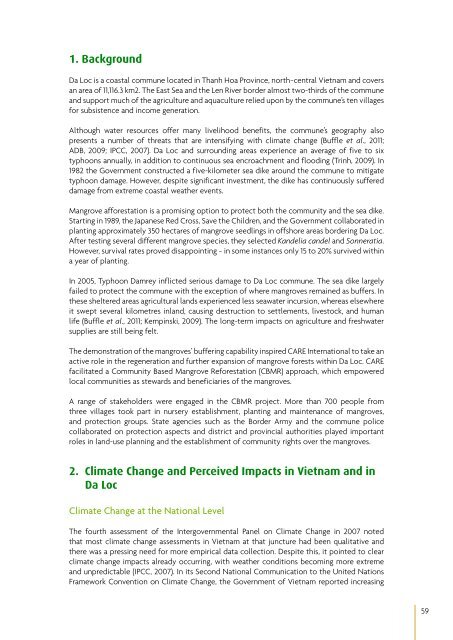Adaptation case studies.pdf - RECOFTC
Adaptation case studies.pdf - RECOFTC
Adaptation case studies.pdf - RECOFTC
You also want an ePaper? Increase the reach of your titles
YUMPU automatically turns print PDFs into web optimized ePapers that Google loves.
1. BackgroundDa Loc is a coastal commune located in Thanh Hoa Province, north−central Vietnam and coversan area of 11,116.3 km2. The East Sea and the Len River border almost two-thirds of the communeand support much of the agriculture and aquaculture relied upon by the commune’s ten villagesfor subsistence and income generation.Although water resources offer many livelihood benefits, the commune’s geography alsopresents a number of threats that are intensifying with climate change (Buffle et al., 2011;ADB, 2009; IPCC, 2007). Da Loc and surrounding areas experience an average of five to sixtyphoons annually, in addition to continuous sea encroachment and flooding (Trinh, 2009). In1982 the Government constructed a five-kilometer sea dike around the commune to mitigatetyphoon damage. However, despite significant investment, the dike has continuously suffereddamage from extreme coastal weather events.Mangrove afforestation is a promising option to protect both the community and the sea dike.Starting in 1989, the Japanese Red Cross, Save the Children, and the Government collaborated inplanting approximately 350 hectares of mangrove seedlings in offshore areas bordering Da Loc.After testing several different mangrove species, they selected Kandelia candel and Sonneratia.However, survival rates proved disappointing − in some instances only 15 to 20% survived withina year of planting.In 2005, Typhoon Damrey inflicted serious damage to Da Loc commune. The sea dike largelyfailed to protect the commune with the exception of where mangroves remained as buffers. Inthese sheltered areas agricultural lands experienced less seawater incursion, whereas elsewhereit swept several kilometres inland, causing destruction to settlements, livestock, and humanlife (Buffle et al., 2011; Kempinski, 2009). The long-term impacts on agriculture and freshwatersupplies are still being felt.The demonstration of the mangroves’ buffering capability inspired CARE International to take anactive role in the regeneration and further expansion of mangrove forests within Da Loc. CAREfacilitated a Community Based Mangrove Reforestation (CBMR) approach, which empoweredlocal communities as stewards and beneficiaries of the mangroves.A range of stakeholders were engaged in the CBMR project. More than 700 people fromthree villages took part in nursery establishment, planting and maintenance of mangroves,and protection groups. State agencies such as the Border Army and the commune policecollaborated on protection aspects and district and provincial authorities played importantroles in land-use planning and the establishment of community rights over the mangroves.2. Climate Change and Perceived Impacts in Vietnam and inDa LocClimate Change at the National LevelThe fourth assessment of the Intergovernmental Panel on Climate Change in 2007 notedthat most climate change assessments in Vietnam at that juncture had been qualitative andthere was a pressing need for more empirical data collection. Despite this, it pointed to clearclimate change impacts already occurring, with weather conditions becoming more extremeand unpredictable (IPCC, 2007). In its Second National Communication to the United NationsFramework Convention on Climate Change, the Government of Vietnam reported increasing59
















